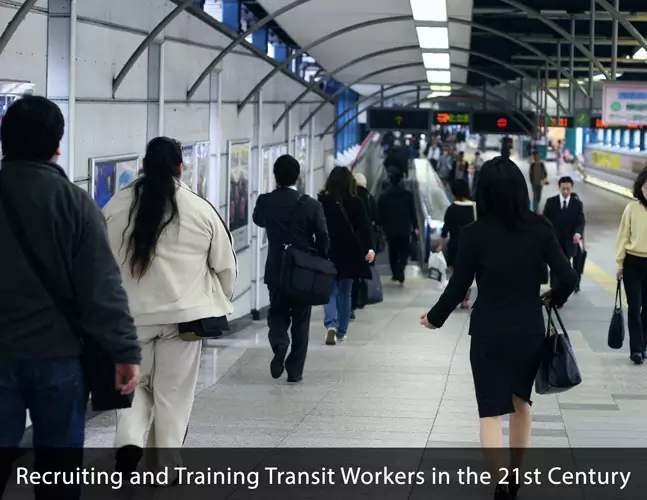Recruiting and Training Transit Workers in the 21st Century

While some transit jobs, such as train operators, continue to go into decline, the demand for bus, rapid rail and subway operators, especially in urban areas, continues to rise. The growing need for urban transit workers is driven by two factors. First more people are moving back into city centers and as a result, they are trading their cars for more convenient and cost effective modes of public transportation. Second, at the same time, a growing number of people in cities and suburban areas are opting for public transportation as an environmental sustainable option.

As older transit workers retire, however, recruiting younger workers to the industry continues to prove challenging. This is due to the fact that few high school or two-year college programs lead people directly into the transit industry and because many younger workers view the transit industry as antiquated. Recruiting and training transit workers, then, poses a unique set of challenge. Nevertheless, transit organizations across the US are rising to the challenge and in some cases, leveraging online tools to tackle their dual recruitment and training crisis.
Changing Misperceptions about the Industry
While younger workers often assume that working in the transit industry is simply about driving a bus or operating a subway, new technologies continue to change the industry. Indeed, today, digital electronics, computers and microprocessor-based systems are part of all large US transportation systems, and the industry increasingly is looking to recruit workers who are comfortable working with such technologies. A combination of public awareness campaigns and recruitment drives on campuses is helping to quell misperceptions and recruit younger workers.
Training through Apprenticeships
The work performed in the transit industry is unique and as a result, recruiting workers from other industries is not necessarily an option. For this reason, apprenticeships play a critical role in the transit industry. In comparison to many European countries, however, apprenticeship-based training programs continue to lag behind in the US. Nevertheless, there’s a growing attempt to create rigorous, carefully monitored and continuous training programs.
Combining classroom training with on-the-job training, apprenticeship programs are an effective way to recruit and train workers, because they offer a way for young workers to gain critical skills while earning a living and introduce skills in context. In other words, with apprenticeships, workers acquire skills and are asked to immediately put them into action in real work scenarios. There are also long-term advantages to the apprenticeship model. Unlike discrete training courses, apprenticeships often continue over time and as a result, they instill a culture of lifelong learning into the workplace.
Training Challenges
While great strides have been made in recruiting and training new workers, there are a few challenges that continue to plague the transit industry. First, since many of the existing workers are older, the people most well positioned to serve as mentors in apprenticeship programs sometimes lack the technical skills required to train new workers. For this reason, some regional transit authorities have discovered that implementing apprenticeship programs requires them to simultaneously scale up training for existing workers. Second, in small cities, the challenge can be even more dire given the shortage of skills workers. For this reason, some smaller cities have begun to partner with larger municipalities to create apprenticeship programs that bring workers from one region to initial training or to enhance an existing set of skills. Regional partnerships have proven efficient and effective in part because they make the most of knowledge already available in the industry, eliminate the need for expensive training centers and empower workers at different stages in their careers. Moving forward, however, there is much more than the transit industry can do to recruit and train younger workers. Among other strategies, the industry may further exploit the use of virtual worlds and other eLearning and mLearning options in both recruitment and training initiatives.